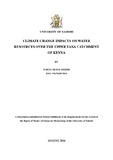| dc.description.abstract | The hydrological regimes and cycles within a certain watershed can be altered by the global climate variability and change. This alteration adversely impacts on environmental sustainability, water resources, agriculture and ecosystems. The Upper Tana Catchment in Kenya is the source of the upstream flows of the large Tana River basin. It is also a home to the major hydropower dams in Kenya and so it is the power house for the electricity supply in the country. This therefore makes the catchment one of the most important water areas in the country. Understanding and prediction of connections between the water systems and climate change are the primacy science essential and challenge areas. The study aimed at establishing the probable future status of Upper Tana Catchment water resource availability under different future climate scenarios through modeling framework.
Observed datasets for temperature and rainfall used were acquired from the Kenya Meteorological Department (KMD) and river discharge data used were from the Ministry of Water and Irrigation (MWI). The KMD and MWI datasets were for the period 1951-2014 and 1963-2000 respectively. SWAT data input comprised of Digital Elevation Model (DEM) with a 90m resolution topography data from Shuttle Radar Topography Mission (SRTM). The Land Use data were acquired from the United States Geological Survey (USGS) and soil data from Kenya Soil and Terrain (KENSOTER). The climate projection datasets for the RCP4.5 and RCP8.5 were obtained from IGAD Climate Prediction and Application Centre (ICPAC) for the period 2006-2100.
The data were subjected to various methods in order to define the temporal patterns of climatic and hydrological characteristics at specific locations within the study area. Trend analysis with test using Mann-Kendall (MK) was applied in analyzing the past, current and future climate and water resource status over the catchment. To assess the changes in the rainfall and surface air temperature the Gaussian Kernel density distribution was used. The period 2021-2100 was divided into three climatic periods from 2021-2040, 2051-2070 and 2081-2100. These are the climate in the 30‟s, 60‟s and 90‟s respectively with 20 years of data each. The climatological periods were used analyze the climate projection. The baseline period was taken to be from 1995 to 2014 against which comparison was made.
Results show that rainfall is generally increasing gradually and that the future temperatures are also expected to rise at an alarming rate over the catchment in both RCPs. However, a
vi
greater rate of increase in temperature was observed in RCP8.5 compared to RCP4.5. To evaluate how change in climate may influence the water resources within the Upper Tana, the outputs as shown by changes in the water yields from calibrated and confirmed Soil and Water Assessment Tool (SWAT) were used.
Due to variations in the projected precipitation and temperature in both space and time, different hydrological implications are likely to be caused by climate change. Based on temperature (minimum and maximum) and rainfall changes, the climate change effects on water yields were simulated on a monthly basis. A baseline period of 1970 to 1989 for the observed river flows for the station 4ED03 was used to assess how the water yields over the Upper Tana catchment will be impacted by climate change. This was analyzed against the simulated future river flows for the period 2021-2040, 2051-2070 and 2081-2100.
Results suggest a future increase in the long term yields of water related to the baseline period from January to March for the three climatic phases in RCP4.5 climate change scenario. A reduction in future water yields for MAM rainfall season is depicted in all the climatic periods while a future increase in the water yields in the OND rainfall season. The same tendency of decrease in the future long term water yields during the long rains and an increase in the future water yields in the short rains was also observed in the RCP8.5 climate change scenario for the three climatic periods. Due to precipitation and temperature variations, water yields will be altered by the changes in the climate in the long term. The variation in the river flows during rainy seasons over the catchment has implications on the water quantity and quality, agriculture, energy production sectors and needs for the aquatic habitat.
The results from the study may perhaps enlighten decision making in water sector in terms of development projects implementation in both short and long terms and also strategic planning. These results can also be used in management of water resources and disaster control in the water sector. In understanding the extent of vulnerability of the Upper Tana Catchment water resources to the climate change impacts, policy makers can also use the results from this study. This will help in coming up with suitable mitigation and adaptation approaches. The use of integrated hydrological modeling in impact assessment and the inclusion of other factors that cause imbalance in the water should be enhanced in the Upper Tana Catchment. | en_US |



